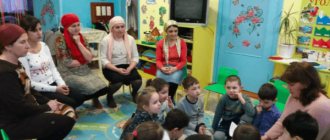Long-term planning for the Drama section
</ Перспективное планирование в средней группе.
Educational field: "Communication"
Section: “Drama” Develop children’s creative abilities through theatrical activities. Encourage yourself to look for expressive means (gestures, movements, facial expressions) to create an artistic image. Cultivate a desire to control theatrical puppets. Improve children's artistic skills.
1
3
Musical game “Bunny Come Out”
Learn to reproduce the text of a familiar fairy tale in a theatrical game, develop memory, learn to convey the mood of the characters with intonation, and cultivate a sense of empathy and sympathy.
1
4
Theatrical game "Cat and Mouse"
Teach children to act with a game plot, to convey the habits of cats. Develop artistic abilities.
1
5
Theatrical game "Turnip"
Encourage improvisation using means available to every child. Learn to coordinate your actions with the actions of your partner.
1
6
Game-dramatization based on the fairy tale “Kolobok”
Develop imagination, pantomime skills, expressiveness of gestures. Strengthen the ability to interact with a dialogue partner. Cultivate interest in theatrical activities.
1
7
Dramatization of the Kazakh fairy tale “The Stupid Wolf”
Develop imagination and expressiveness of gestures. Learn to control your body freely. To form the simplest figurative and expressive skills. Develop speech, memory, thinking.
1
8
Pantomime game “There was a bunny’s garden”
Learn to understand the moral meaning of the events depicted. Coordinate your actions with the actions of your partner. To develop interest in theatrical games.
1
9
Production of the Kazakh folk tale: “Three Friends”
Continue to introduce Kazakh oral folk art - everyday fairy tales. Develop memory, thinking, attention.
1
10
Finger Theater "Teremok"
Develop interest in theatrical activities. Develop thinking, memory, attention. Cultivate interest in theatrical activities. Learn to coordinate your actions.
1
11
Dramatization of the fairy tale “The Tailor Hare” by M.Yu. Kartushina
Introduce children to fairy tales from different peoples of the world. Teach children to evaluate the actions of fairy tale characters. Cultivate interest.
1
12
Dramatization of the literary work of L. Tolstoy “The Jackdaw Wanted to Drink”
Learn to convey the meaning of a story close to the text. Expand children's understanding of the jackdaw. Cultivate interest and respect for birds
1
13
Dramatization of the literary work “The Very Big Apple” by B. Zhitkov from the series of stories “What I Saw”
To develop an interest in fiction by introducing children to the cross-cutting character of the “Smart Ant” series. Develop children's speech using methods and techniques for enriching and activating vocabulary.
1
14
A fairy tale is a pantomime.
"Bunny and Hedgehog"
Strengthen children's ability to stage pantomimes. Encourage children to create a holistic artistic image.
1
15
Acting out situations “I don’t want semolina porridge”
Learn to pronounce phrases with intonation and expressiveness. Perform movements and actions in accordance with the logic of the characters’ actions, taking into account the location of the action. To develop interest in theatrical games.
1
16
Dramatization of the Russian folk tale “Fear has big eyes”
Encourage children to dialogue with adults and peers, to play and verbal interaction with them; develop speech attention and the articulatory apparatus of children.
1
17
Improvisation, dramatization of a Russian folk tale using bibabo dolls “Two Greedy Little Bears”
Encourage improvisation using available means of expression. Teach children to control the strength of their voice, timbre, and tempo of speech appropriate to the character.
To develop interest in theatrical games.
1
18
Dramatization of the Russian folk tale "Geese Swans"
Learn to justify a given image, coordinate your actions with the actions of your partner. Develop intelligence, imagination and fantasy.
1
Result:
18
Long-term plan for working with middle-aged children
Objectives of theatrical entertainment activities for middle-aged children:
Continue to develop and maintain children’s interest in theatrical activities by acquiring more complex gaming skills (monitor the development and interaction of characters)
Develop performing skills (role embodiment, ability to act in an imaginary plan)
Perform simple performances based on familiar literary works, using expressive means (intonation, facial expressions) to embody the image.
Introduce various types of theater (stand theater, mask theater, plane picture theater, finger theatre, picture theater on the hand, riding puppet theater (puppets on “spoons”) - help children accumulate ideas about various types of puppet theater, scenery, teach techniques puppeteering of various types of dolls.
Expected results:
By accumulating emotional and sensory experience and interacting, children will begin to take initiative and offer new roles or actions that enrich the plot.
In independent theatrical games, they will begin to arrange a place for the game, to embody the role (movements, intonation, facial expressions)
Master the techniques of puppeteering various types of puppets.
Children treat each other kindly; become more confident.
Perspective lesson plan “Theater of Everything”, middle group
| № | Name | Month |
| 1 | 1. “We are playing theater” - articulation gymnastics 2. “We are future artists” - exercises for the development of expressive plasticity of movements, for the development of expressive facial expressions. 3. “I’ll change myself, friends, guess who I am?” - dressing up in costumes, imitation sketches 4. Sign language - conversation with children | September |
| 2 | 1. Theatrical sketch “About Mushrooms” - reading and conversation based on the content, searching for expressive intonations, facial expressions, gestures to convey the image. 2. The fairy tale “Colors of Autumn” - work on individual episodes, expressiveness of speech 3. Display of a fairy tale with scenery details, musical accompaniment, and costume elements. Theatrical dictionary “Costumer”, “Make-up artist”. 4. The “Generous Autumn” holiday - enrich with vivid impressions, evoke a desire to take an active part in the holiday. | October |
| 3. | 1. “It’s very difficult to live in the world without a girlfriend or boyfriend!” Reading a poem - “Say a kind word about a friend”, Performing the song “If you went on a journey with a friend”, music. V. Shainsky 2. The fairy tale “Teremok in a new way” - to cultivate the ability to monitor the development of actions, to involve in the telling of a fairy tale, to convey the character and emotional state of the selected personnel. 3. The fairy tale “Teremok in a new way” - arouse interest in what is happening, intonationally and expressively convey the character of the selected personnel. 4. Showing fairy tales to children of other groups. | November |
| 4 | 1. Comic performances and pantomimes 2. Staging “On a visit to the Christmas tree” - creative tasks, distribution of roles 3. Theatrical game “Circus of Animals” - consolidating the elements of acting, memory, and imagination in the game. 4. “New Year’s holiday!” - create a joyful mood, evoke a desire to actively participate in the holiday. | December |
| 5 | 1. Creative games: “Good - bad” - rules of behavior in the theater, players portray using facial expressions and pantomime. Game “Animals in the Zoo”, game “Animal Voices” 2. "Christmas festivities" 3. Picture theater “We play and sing” 4. Introduction to the puppet theater | January |
| 6 | 1. Dramatization of familiar songs 2. Tabletop theater 3. “The Gray Wolf and Little Red Riding Hood”, based on the fairy tale by C. Perrault. Conversation on content. Getting into character. 4. “The Gray Wolf and Little Red Riding Hood” - convey the character and emotional state of the selected character intonationally and expressively. | February |
| 7 | 1. Showing the fairy tale “The Gray Wolf and Little Red Riding Hood” at the All Ladies’ Day, using musical costumes and attributes. musical arrangement. 2. Theatrical game “Pump” and inflatable toy: act with imaginary objects, interact with each other. 3. Finger theater “Fox, Hare and Rooster” - work on individual episodes, on the expressiveness of speech. 4. Showing the fairy tale “The Fox, the Hare and the Rooster” to children of younger groups. | March |
| 8 | 1. “We played and danced” - imitation of accompanying nursery rhymes on children's musical instruments. 2. Improvisation on a theme using sounding movements 3. Song improvisation 4. Flannelograph Theater | April |
| 9 | 1. Comic poems: play around, assign roles yourself 2. Sound therapy 3. Fabulous concert. Dramatizations of fairy tale fragments. “There are many fairy tales in the world - kind and funny, and we cannot live in the world without them.” | May |

